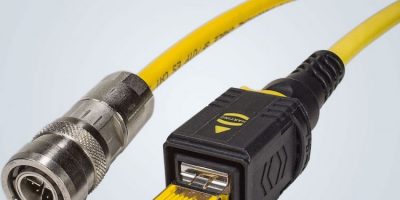Plastic connectors are rugged for transport
The Han-Eco plastic connector series has been extended by Harting to include housings in Han B, which are plug-compatible with Han connectors in metal housings.
Harting claims to offer the largest selection of contact inserts for industrial connectors, with more than 100 different modules and monoblocks available for the transmission of power, data, signals and compressed air.
The plastic housings are lightweight and can be mounted quickly. Unlike standard connectors, where cables must be routed through a mounting cut-out in order to assemble the inserts on the control cabinet, the Han-Eco B monoblocks and modular inserts can be pre-assembled and snapped directly into the mounting housing, easing assembly by allowing harnesses and control cabinets to be prepared separately for final assembly.
By using smaller connectors, including modular types, more functions can be combined in a smaller space. This reduces the weight of the connectors, but also their space requirements for flexibility when designing rail vehicles.
Harting has developed the High Pressure Railway (HPR) housing series, in which more connector modules are fitted into a single housing. One of the largest HPR housings, the Han 34 HPR, can now accommodate up to four 650A high-current contacts or 12 Han-Modular single modules. Conventionally, two housings each had to be equipped with six Han-Modular individual modules to supply a comparable data volume.
To reduce weight in railway applications, Hating has also introduced the Han 22 HPR Slim motor connector, which is particularly suitable for underfloor applications due to its compact, flat design. Miniaturisation has resulted in space for four contacts in the connector without sacrificing performance, says Harting.
To save weight and still be able to handle the same volume of data, Harting’s future rail technology offering will rely on Ethernet via single twisted pair and small T1 connectors according to IEC 61076-3-125. For cable lengths up to 40m, IEEE 802.3bp (1000 BASE-T1) can transmit 1Gbit per second, using cable that is about one-third lighter than conventional eight-wire Ethernet cable. Commercially available Ethernet cable with four wire pairs for 1/10Gbits per second Ethernet weighs about 45kg per kilometre. A single-pair cable with the same bandwidth weighs only 30kg per kilometre. To illustrate the potential weight savings, Harting points out that there are several kilometres of cable installed in the coaches of passenger trains.
PushPull connectors simplify assembly and service in the railway sector and the M12 circular connector is now also available with PushPull locking. For device connection technology, there is also the PushPull system in the square connector variant four. Both with M12 and with variant four, the secure transmission of power, signals and data up to Cat.6A can be managed without problems.
PushPull connectors have tool-free installation, regardless of whether round or square versions are used. An audible click signals that the connectors have been securely locked and correctly connected, saving up to 75 per cent assembly time says Harting.
In trains, IGBT semiconductor elements control high-performance electric drives, which are connected to the required insulation via plastic fibre optic cables. Previously, the connection between controller and driver board was managed using single fibres. The electro-optical conversion of the signals takes place in the transceivers of the PCB where optical contacts make the connection to the fibres. Each optical fibre has a single connector on both the driver and controller boards that house the transceivers. With this previous solution, all transmit and receive elements on the controller board require significant space, and the board is unnecessarily enlarged. Harting now offers users a miniaturised solution in IGBT control, the Multifibre module, based on a transmission principle that includes the transfer of the transceivers of the controller board into a pluggable module, integrating the optical interface according to the principle of “plug electrically and transmit optically”. In the future, only a robust interface rather than up to 16 sensitive optical contacts will need to be accessed for maintenance purposes.




